Book contents
- Frontmatter
- Contents
- Acknowledgements
- 1 Introduction
- Part 1 Training practices
- 2 Different approaches to learning and teaching
- 3 Making training interesting
- 4 Use of different technologies to support training practices
- 5 Making it happen
- 6 Delivering face-to-face training sessions
- 7 E-learning and blended learning
- Part 2 Learning in the workplace
- Index
5 - Making it happen
from Part 1 - Training practices
Published online by Cambridge University Press: 08 June 2018
- Frontmatter
- Contents
- Acknowledgements
- 1 Introduction
- Part 1 Training practices
- 2 Different approaches to learning and teaching
- 3 Making training interesting
- 4 Use of different technologies to support training practices
- 5 Making it happen
- 6 Delivering face-to-face training sessions
- 7 E-learning and blended learning
- Part 2 Learning in the workplace
- Index
Summary
Introduction
This chapter is concerned with the activities that need to take place in order to ensure that training events are well designed and evaluated, and also marketed and promoted. The starting-point for thinking about any training event is the learners and their needs, and this is explored under the headings: library and information users and their needs; supporting learners with disabilities; and working with international students.
This is followed by a detailed section on designing training events. Why spend time designing learning and teaching activities? There are a number of reasons for taking the time to work out the detail of your training programme and these include:
• giving yourself confidence
• focusing your thinking on the learners
• preparation of learning materials
• meeting problems with contingency plans
• thinking through the whole event
• reduced likelihood of making basic errors
• looking professional.
The section covers basic design principles and explores different approaches to structuring face-to-face training events. (E-learning and blended learning programmes will be considered in Chapter 7.) The design of a training event involves thinking about evaluation and incorporating this into the structure of the event. Frequently, evaluation is considered at the end of books on training, but if it is to be properly designed, then it needs to be considered at the same time as the design process. The Kirkpatrick (1994) model is used to describe different levels of and approaches to training evaluation.
The last section in this chapter focuses on marketing and promoting training events. It describes common approaches to ensuring that the appropriate participants attend training events and ends with a series of case studies which explore current practice.
Example 5.1 Planning and designing training events
Harding (2012) writes:
To be effective, training courses demand meticulous and lengthy planning. They must be geared to the needs of the delegates, and to organisational needs. I spend a lot of time in preliminary discussions about these issues with training providers. Sometimes they change what they have initially asked for as a result, realising that an amended focus or methodology is likely to be more successful.
- Type
- Chapter
- Information
- The No-nonsense Guide to Training in Libraries , pp. 89 - 112Publisher: FacetPrint publication year: 2013



